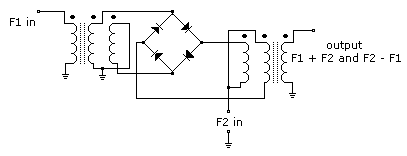
The sad fact is, the amp still sees the same load and does the same work it would in an equivalent single-wire connection.
There are also claims of division of labor. Again, the amp still does all the work. The division still occurs in, and only in, the crossover sections.
The ONLY real way to get true division of labor is to bi-amplifiy. In other words, move the crossover ahead of the amplifiers and use one amp per half of each speaker.
Then there are the claims of improved IM(inter-modulation) distortion.
To begin with, wires do not introduce IM distortion products, only the amp and very poor connections can do that. Why? Because it takes a non-linear system to generate IM. Amplifiers aren't perfectly linear and will generate some. Poor connections will be unable to adequately transfer power and will likewise generate IM because of the "semi-conductor" junction formed.
Let's look at an example that shows that cables do not generate IM:
We will look to the rf(radio frequency) communication industry. Many police and other large municiple departments communicate on what is known as a tunking system. This is a complex multi-station system(up to 20) that makes maximum useage of available channel resources.
These systems will combine multiple transmitters onto a SINGLE FEEDLINE and then feed a single antenna. Guess what, as long as the transmitters are isolated from one another(because they are VERY non-linear, class-C outputs), there is no IM. End of story.

The point is, a mixer is designed to deliberately generate IM. Diodes are non-linear devices, so when you put 2 signals together(f1 and f2), you get out what was shown in the mixer image above, which is the algebraic sum of the input signals.
From that, the engineer picks the one he wants and filters out the rest. Plain ol' wires just can't do this trick.

The two big spikes at the right are the test signals, the big spike nearly falling off the left is 0Hz and can be ignored. All the little spikes are IM products. Before you get too hysterical, please note that the worst ones are down 65dB, which equates to a worse case IM of 0.056%. Many amps are 0.01%, or 80 dB down.